Adobe Audition is a powerful digital audio workstation (DAW) and has many capabilities to produce slick, professional results. Whether working in a fully-professional studio environment, for a YouTube video, voice over, or on projects at home, the range and breadth of what Adobe Audition is capable of can help turn almost any audio into something really special.
In this article, we are going to address how to fine tune and improve sound quality regardless of your voice type.
There are plenty of tips, tricks, and skills that can be used in conjunction with Audition to get the best-sounding voice possible. Whether you’re looking to hit the high notes on vocals, editing a podcast so your posts sound rich and resonant, or editing a YouTube video in Premiere Pro, Adobe Audition is there to help.

The Basics: Voice Recording
When it comes to recording, it’s important to get the basics right. While software can do a great deal to improve the quality of your voice, the better the original recording, the easier it will be to work with.
The quality of your equipment and audio interface is also important. Not all microphones are equal, so invest in one which is suitable for what you're going to record. Some will be better for singing, some will be better for the spoken voice. The first thing is to choose the right one for your project.
Editing
Before you start applying effects to your vocal, edit everything into its finished form.
There is a good reason for doing this step first. Moving audio around after you have started applying effects can result in changes. That can mean a lot of extra work — getting something right, then moving it, then having to get it right again and again. It’s better to get everything into its final form and then apply the effects — editing first, production second.
Noise Reduction: Eliminate Background Noise
Unless you have an extremely professional set-up, there can always be unwanted noise when you record. It could be hiss from equipment, someone moving around your house, or even just a car driving past.
It’s a good idea to leave a little “silence” at the beginning or the end of your track when you record. This can give Audition a noise profile which is then used to eliminate background noise that's been accidentally picked up in your audio file.
Noise Print
To use Noise Reduction, highlight a few seconds that contain potential noise, but not the whole track.
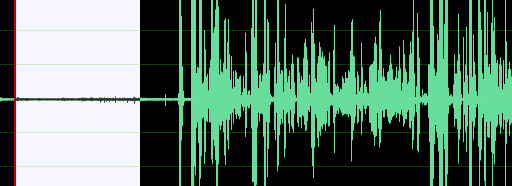
Go to the Effects menu, choose Noise Reduction / Restoration from the drop down menu, and then Capture Noise Print.
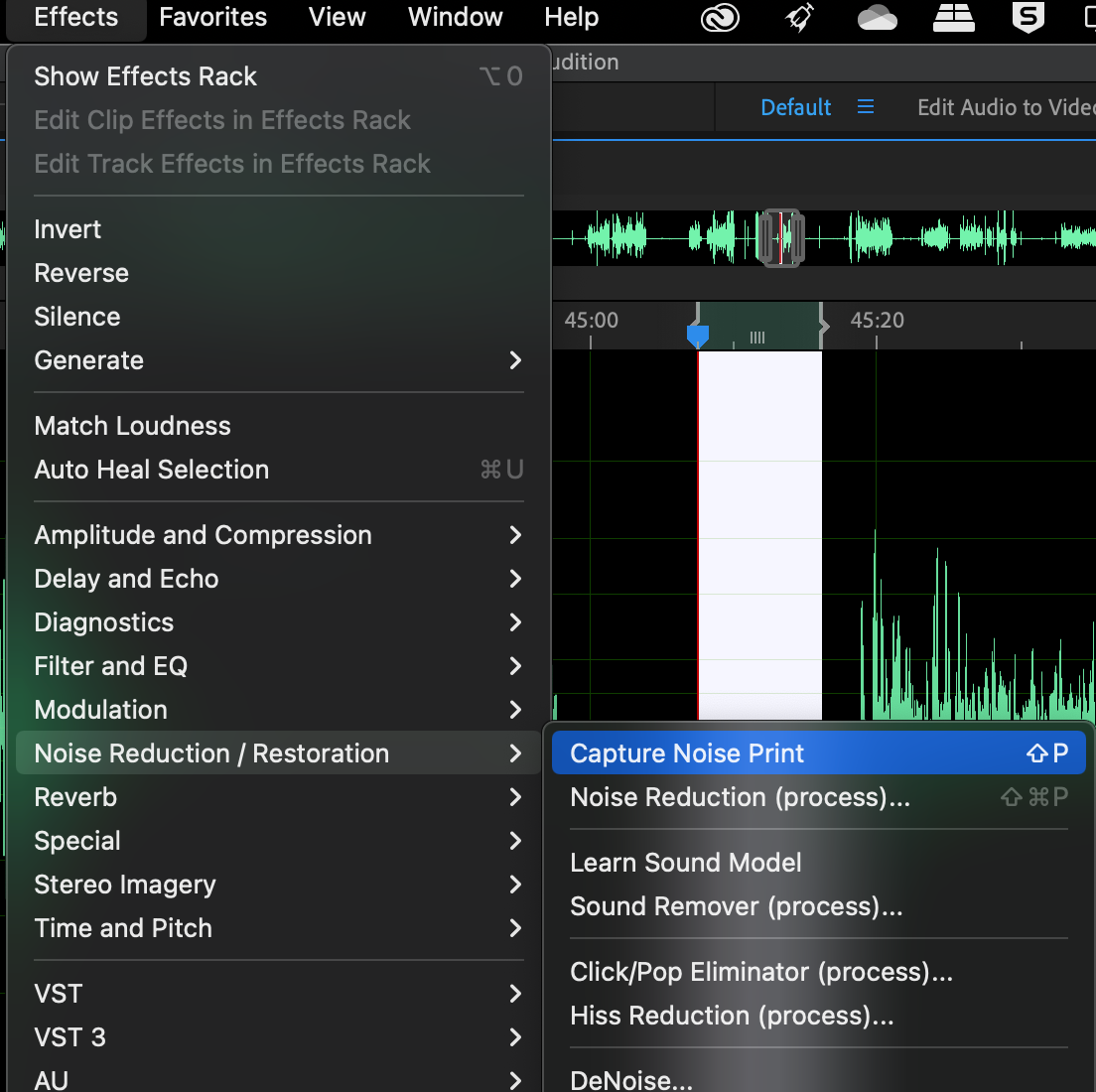 KEYBOARD SHORTCUT: SHIFT + P (Windows), SHIFT + P (Mac)
KEYBOARD SHORTCUT: SHIFT + P (Windows), SHIFT + P (Mac)Once done, select the entire audio track.
KEYBOARD SHORTCUT: CTRL + A (Windows), COMMAND + A (Mac)Go to the Effects menu and select Noise Reduction / Restoration, then Noise Reduction (process). This will open the Noise Reduction dialogue box.
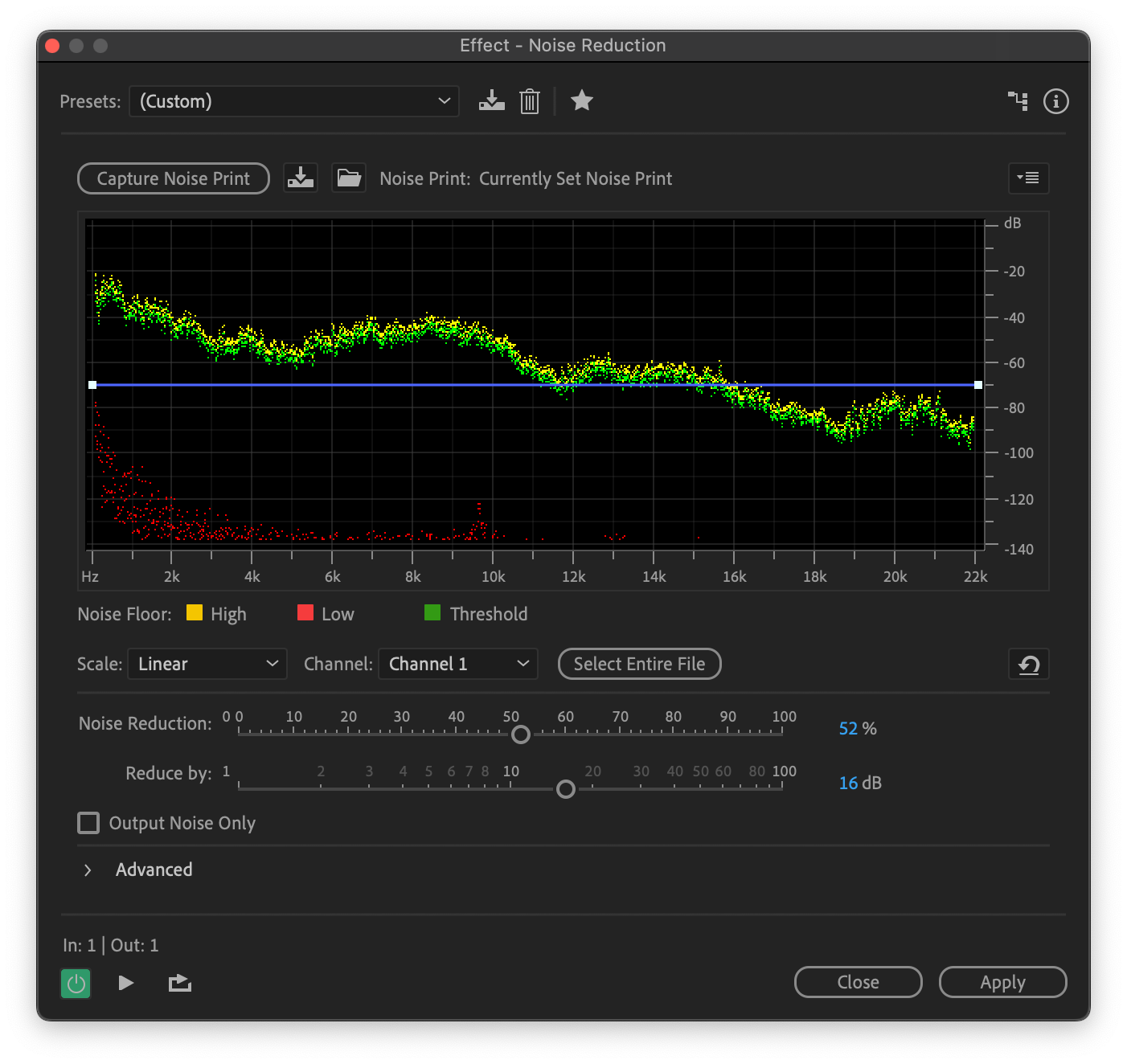 KEYBOARD SHORTCUT: CTRL + SHIFT + P (Windows), COMMAND + SHIFT + P (Mac)
KEYBOARD SHORTCUT: CTRL + SHIFT + P (Windows), COMMAND + SHIFT + P (Mac)-
Settings
You can adjust the Noise Reduction and Reduce by sliders to adjust the amount of noise reduction you require. It can take a little practice to get right, but you will hear a significant difference even with the default settings.
Click on the Preview button to check you have the correct levels and that they sounds good.
When you are happy with the results, click Apply.
Normalization: Make Everything The Same Volume
Normalizing is the process of making different recordings have the same volume.
If you record two podcast hosts, with one speaking quietly and one speaking loudly or using a condenser and a dynamic mic, you want them to be at the same volume. This avoids a big change in levels every time a different host speaks and maintains the dynamic range.
Go to the Effects Menu, select Amplitude And Compression, then select Normalize (process) to bring up the Normalize dialogue box.
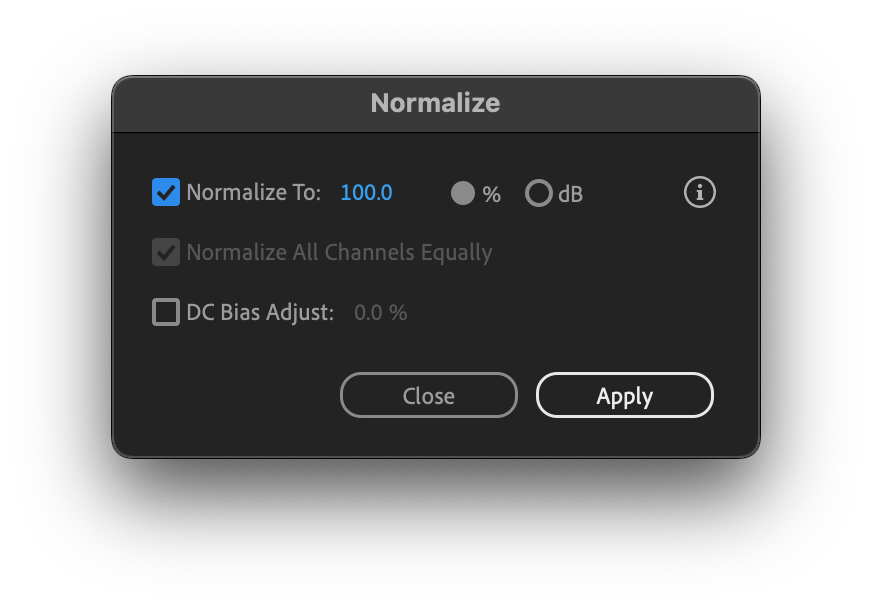
Settings
The Normalize To setting lets you set the loudest part of your track. This can be done either by percentage or by decibels (dB). It’s usually a good idea to set this a little under the maximum so there’s space left for a few effects you might want to apply. Anything between -1 and -7 for the loudest part should be fine.
The Normalize All Channels Equally uses all channels of a stereo recording to work out how much amplification to apply.
If the option is not selected, the amount of effect applied to each of the stereo channels can result in one being changed a lot more than the other. If the option is selected, each stereo channel will be adjusted by the same amount. This results in both channels being the same volume.
The DC Bias adjust simply sets the middle of your waveform to zero. You can almost always leave this option selected and set it to 0.0%.
Once you have made your selections, hit Apply, and your tracks will be normalized.
Parametric Equalizer: Make a Voice Richer and Remove Noise
Once the tracks have been normalized, it’s a good idea to use the parametric EQ. This can add depth and range to how a vocal sounds, as well as additional noise elimination.
EQing allows the adjustment of specific frequencies within the vocal track. For example, by increasing the bass in a voice, you might make it more resonant.
Go to the Effects menu, then Filter and EQ, and select the Parametric Equalizer option. This will open its dialogue box.
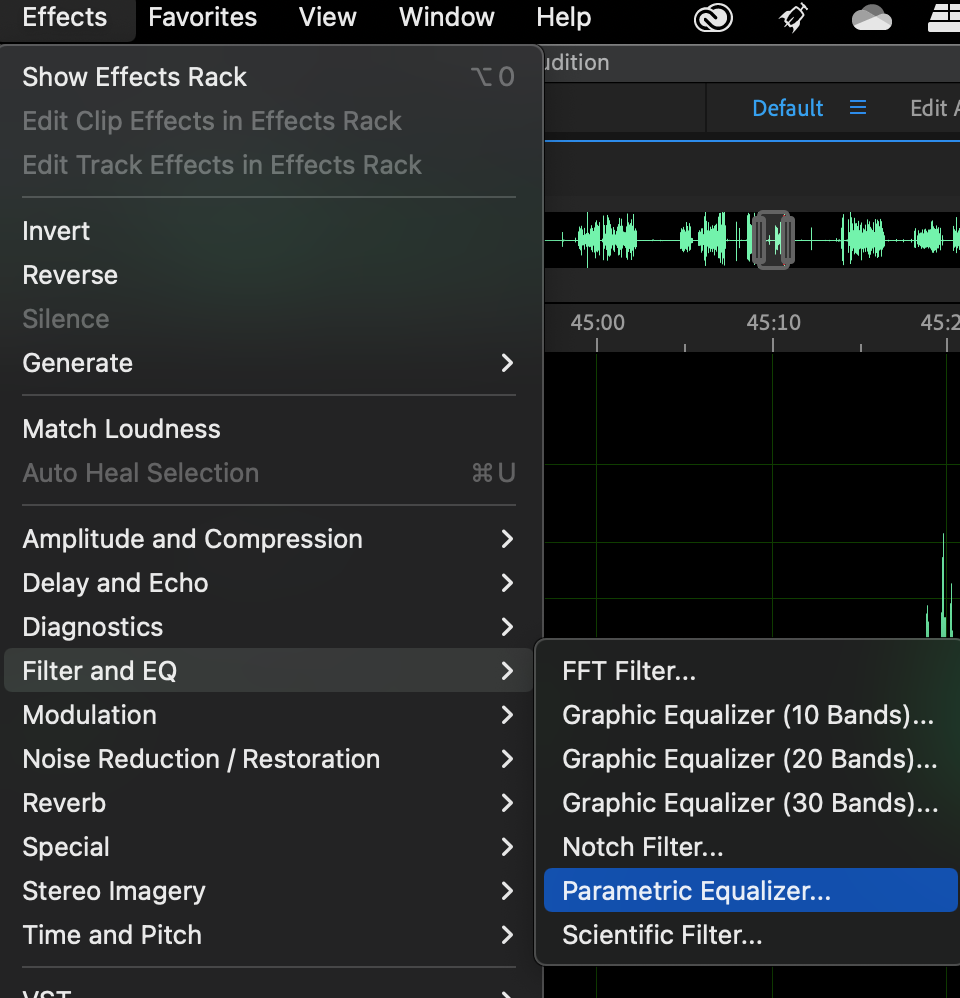
Settings
Each white dot on the frequency represents a point that can be adjusted. Not every part of the frequency will necessarily need to be adjusted. You can decide what to change based on the voice recording that you have.
There are some points to consider:
- Some voices may need more bass, in which case, adjust the lower end of the spectrum. Some might need to be brightened up, so adjust the higher end. The middle frequencies can make a voice richer and fuller.
- You can adjust the very highest or lowest frequencies to eliminate any hum or hiss that might still be on the track even after you have reduced noise. You may find these options as low and high pass filters.
- The gain controls how loud the change is — basically, the volume.
- Adjusting the Q / Width setting will control how much of the frequency is adjusted. You can keep this narrow to have very fine control, or wide to have a broader effect.
There is no “correct” way to EQ a voice because every voice is different.
Even when you record the same spoken voice, it can be different depending on when the voice was recorded, the room tone, how the person sounded at the time, whether they were recorded in the same environment, and so on. The best thing to do is simply experiment until you hit the exact settings you need.
However, it is a good technique to adjust by no more than five decibels (dB) so the effects are noticeable but do not overwhelm the original recording.
Compression
Adobe Audition has a single band compressor, which can help to balance and even out your sound.
Go to the Effects menu, select Amplitude and Compression, then Single-band Compressor. This will open the single band compressor dialogue box.
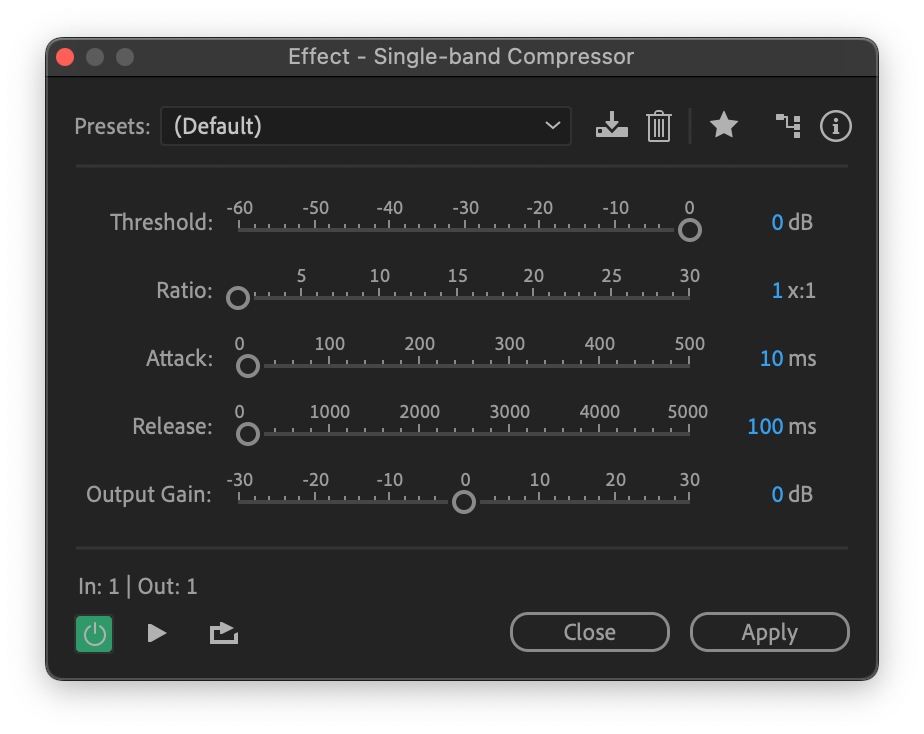
Settings
- The Threshold is the point at which the compressor will start to take effect. You want to set this so it covers where the majority of the audio signal is.
- The Ratio controls how much effect will be applied — the higher the ratio set, the more fully compressed the audio file will be.
- The attack setting controls how long it takes the compressor to work on the signal, and the release setting controls how long it takes to stop. When processing dialogue, these can normally just be left as default.
- Output gain is how loud the final output is.
The exact parameters for each will depend on the track. The aim is to try and get the audio waveform as consistent as possible so there are fewer peaks and troughs.
Removing Silence: Getting Rid Of Pauses
If you record dialogue, there can always be pauses between people speaking. Maybe a host needs to gather their thoughts, or perhaps there’s simply a lag in the recording. While you can remove these manually by cutting them out, this can be laborious and time-consuming. Fortunately, Audition can do this for you automatically.
Settings
Go to the Effects menu, then Diagnostics, and choose Delete Silence (process).
Click on the Diagnostics tab, then Settings, then choose Fix Settings and select Shortening Silence.
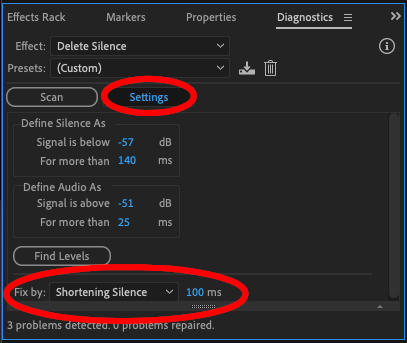
The default setting here is 100ms (100 milliseconds, or one-thousandth of a second) and that’s good for most spoken audio.
Be aware that if the time is too short, it might seem like your hosts are talking over each other, or if the time is too long, there will be awkward gaps.
There is even a preset called "Cleanup Podcast Interview" to help out.
As with EQing, the best approach is to play around until you get the exact settings you need.
Click the Scan button, then click Settings, and Audition will show you where it thinks there are problems. You can Delete All or choose the ones that you think need adjusting.
Good Practice: Normalize Again
After all these changes, you should have a voice that sounds pretty good, just how you want it. However, it’s a good idea to run through the Normalization process one more time. Sometimes, when adjusting frequencies or eliminating noises, it can affect the overall volume of your tracks. Running everything through the Normalizer again ensures that the volume is consistent across all your tracks, even after your changes.
Just follow the same procedure as above. Select the whole track, go to the Effects menu, select Amplitude And Compression, and then select Normalize (process). You can leave these as they were from the first time you ran the Normalize effect. Click Apply and your track will be normalized again.
Conclusion
Adobe Audition contains all the tools necessary for making your vocals better. The whole process is simple but makes a big difference.
Of course, using Adobe Audition’s own tools is only one way to improve the quality of a voice. Check out our guide to the very best Adobe Audition plug-ins for even more options to improve the way a voice sounds and add other things to the effects rack.
We also have our own range of CrumplePop plug-ins which can make a substantial difference to how good a voice sounds.
Hear It For Yourself
Advanced audio AI removes noise and boosts your vocal quality.
Toggle it on/off to hear the difference.
Remove Wind
Remove Noise
Remove Pops & Plosives
Level Audio
Remove Rustle
Remove Echo
Remove Wind
Whether you use the built-in options or opt to go for some of the many plug-ins available, with Adobe Audition, you can be absolutely sure you will transform your voice and vocals into something truly special.







